
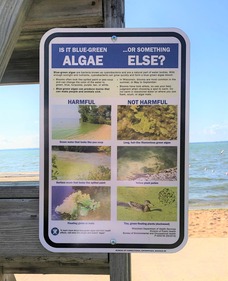
This message is being sent to local public health officers, Tribal health directors, the Harmful Algal Blooms list, and key DPH staff.
The 2024 cyanoHAB season is right around the corner and the DHS HAB program is here to help you prepare! In this issue we will provide you with the information and resources you need to effectively respond to cyanoHABs and related illnesses.
Before we answer all of your burning cyanoHAB questions, we encourage you to take a few minutes to meet the members of Wisconsin's cyanoHAB illness surveillance and response team!
|
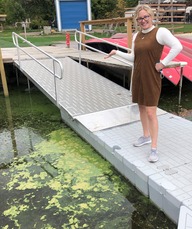
Jordan Murray
Agency: Wisconsin Department of Health Services
Education: B.A., Neuroscience, College of Wooster; M.P.H.-Epidemiology, University of Toledo
Role in cyanoHAB illness investigations: Jordan is a harmful algal bloom epidemiologist with the University of Wisconsin School of Medicine and Public health. She is stationed at the DHS where she is entering her third year as the DHS HAB Program coordinator. During the HAB season, Jordan receives and investigates reports of HAB illnesses, interviews illness complainants, coordinates water sampling and analysis with the Wisconsin Department of Natural Resources (DNR) and the Wisconsin State Laboratory of Hygiene (SLH) and helps local health departments interpret health risks to the public and issue health advisories and beach closures.
Notable career event: In 2022, Jordan had the opportunity to travel to her hometown of Toledo, Ohio, to present with Gina LaLiberte at the International Conference on Toxic Cyanobacteria. She and Gina met with and presented to researchers from across the globe about the work Wisconsin is doing to prevent, manage and mitigate HABs and related illnesses. Jordan enjoyed learning about the international significance of HABs and how other countries are working to address this environmental and public health issue.
|
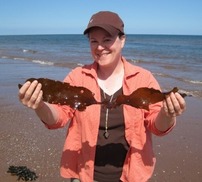
Gina LaLiberte
Agency: Wisconsin Department of Natural Resources
Education: B.S., Biology, University of Michigan; M.S., Resource Ecology Science, University of Michigan
Role in HAB illness investigations: Gina has served as the statewide harmful algal bloom coordinator at the DNR since 2011 and has worked on algae and cyanobacteria for over 30 years. Gina coordinates the DNR’s response monitoring in HAB illness investigations. She coordinates water sampling with regional DNR staff and SLH, reviews and compiles lab results, and sends the results along with background information on interpreting them to local and Tribal public health staff, DHS and DNR staff, and others involved in the investigation.
Notable career event: Gina has many notable accomplishments and fond memories in her 30 years of working with algae and cyanobacteria. She recalls one particular achievement during 2012 when she identified Dolichospermum lemmermannii as the cyanobacterial species forming a large nearshore bloom in Lake Superior at Apostle Islands National Lakeshore. The 2012 bloom spurred ongoing collaboration between federal, Tribal, state, local, and university partners to monitor for and respond to sporadic bloom events in Lake Superior.
|
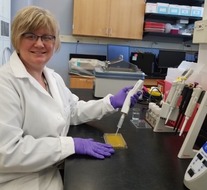
Dawn Perkins
Agency: Wisconsin State Laboratory of Hygiene
Education: B.S., Zoology, UW-Madison; M.S., Limnology and Marine Science, UW-Madison
Role in HAB illness investigations: Dawn is celebrating her 30th anniversary working at SLH and has worked with cyanobacteria for 29 years! During HAB illness investigations, Dawn receives water sample submissions from the water body where the ill person or animal was exposed, microscopically identifies and enumerates cyanobacteria in those samples, analyzes them for various cyanotoxins, and shares the results with DNR and DHS.
Notable career event: Early in her career at the Wisconsin State Lab of Hygiene, Dawn's team received a call from the Wisconsin DNR because they were concerned some wildlife may have been exposed to cyanobacteria toxins in a lake. Water samples were delivered to the lab and her mentor looped her into the situation and they started testing. As it turned out, the samples were indeed cyanobacteria and Dawn and her team confirmed the samples were positive for toxins. This was Dawn's first cyanobacteria investigation and she has been captivated by these fascinating organisms ever since!
|

Rylee Mrachek
Agency: Wisconsin Department of Health Services
Education: B.S., Global Health, UW-Madison; M.P.H., UW Madison
Role in HAB Illness investigations: We are excited to have Rylee serve as the HAB Program's 2024 summer intern! During her internship, Rylee will assist with the HAB investigation process, including interviewing illness complaints, managing and analyzing health-related data, and providing education and outreach to our local partners and the general public. She will also be collaborating with Dr. Paul Block, a professor and researcher at UW-Madison Department of Civil and Environmental Engineering, along with his research group "water systems and society" determining how lake forecasting can be beneficial to public health organizations
Rylee comes to DHS with previous experience as a research analyst for legionellosis within the Bureau of Communicable Diseases at DHS and as an intern with Marathon County Health Department where she performed chemical and microbiological analysis of water samples for the county. She is has a passion for mitigating water quality issues and protecting people from getting sick. Rylee is excited to gain new insights and experiences related to HABs this summer!
Notable career event: One notable accomplishment so far during Rylee's public health career was having the opportunity to serve as the student representative on the Curriculum Committee for the MPH program at UW-Madison.
|
FAQs
What if I receive a report of a bloom?
If you receive a report of a bloom without an accompanying illness, report the bloom to the Wisconsin Department of Natural Resources (DNR) at dnrhabs@wi.gov. Include descriptions of bloom size, duration, and location with lake, town, and county name, as well as any photos taken both close-up and farther away. The DNR is unable to sample and test in response to each bloom report, but may be able to confirm whether cyanobacteria are present from submitted photos. Please note that this email address is monitored during normal business hours, so responses to reports received outside business hours may be delayed.
What if I receive a report of a human illness suspected of being related to a cyanobacterial harmful algal bloom (cyanoHAB)?
Cyanobacteria and cyanotoxin poisoning is a Category II reportable condition in Wisconsin. Cases must be reported to the local public health department or Tribal health center of the jurisdiction where the ill person resides within 72 hours of case recognition. Local health departments should report the suspect case to WEDSS as soon as possible and reference the Case Reporting and Investigation Protocol for guidance. Due to the complexity of case investigation and risk assessment, the DHS HAB Program will work with local health and Tribal agencies on case investigations. The HAB Program has been investigating suspect cases of HAB-related illness for 15 years and will continue to offer technical assistance, including possible water sampling, to local health and Tribal agencies during case investigations.
What if I receive a report of an animal illness suspected of being related to a cyanoHAB?
Report the suspect case to the DHS HAB Program at dhshabs@dhs.wi.gov. The HAB Program will work with the local health agency to investigate the illness. Animal illnesses suspected of being due to cyanoHABs are important to report because they may serve as sentinels for human illness.
Who has the authority to close a public beach or swim area due to a human health hazard (for example, cyanoHAB), and when can they do it?
Per Wis. Stat. § 254.46, The local health officer "…shall close or restrict swimming, diving and recreational bathing if a human health hazard exists in any area used for these purposes on a body of water and on associated land in their jurisdiction and shall require posting of the area." Local health departments and Tribal agencies have primary authority for issuing health advisories, beach or water body closures, and public messaging. An exception exists for state parks and Great Lakes beaches; at many of these locations, the DNR will post signage and close public beaches.
Local health and tribal authorities can issue a health advisory and close a public beach due to cyanoHAB when testing or visual observation suggests a high probability of adverse human health effects (high cyanobacterial cell density, elevated cyanotoxin concentrations, OR a visible cyanobacteria scum layer is present).
New Translated Materials are Here!
The HAB Program strives to make the health information we offer accessible to a wide range of groups—especially populations who may be at an increased risk of HAB exposure. We recently made strides in achieving this goal by translating three of our fact sheets: Blue-green Algae and Dog Safety, Staying Safe and Healthy in Wisconsin's Lakes: What You Need to Know about Blue-Green Algae, and Protecting Your Family From Algal Blooms to Spanish and Hmong. Our next step will be to translate our available signage to Spanish and Hmong. Stay tuned for these new materials!

Lets Get Social
Suggested social media posts and accompanying photos:
|
Example 1
Did you know blue-green algae are not true algae? They are actually called cyanobacteria and are an ancient species who helped create the earth’s atmosphere and water bodies. Cyanobacteria only become a problem when they reproduce and grow to form what are known as cyanobacterial harmful algal blooms. Want to learn more? Visit https://www.dhs.wisconsin.gov/water/bg-algae/defined.htm for additional information and resources.
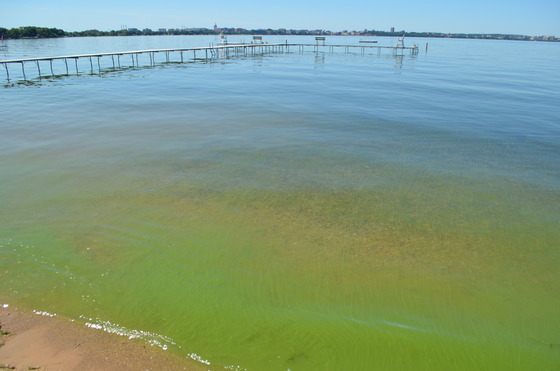 Example 2
Here's a fun fact: cyanobacterial harmful algal blooms have look-alikes! Learn the difference and when in doubt, stay out! Learn more:
https://www.dhs.wisconsin.gov/publications/p01888.pdf

Example 3—Safe Swimming Week: May 20–26
Happy Healthy and Safe Swimming Week! If you're heading to the lake this weekend, be on the lookout for cyanobacterial blooms. Keep your family—especially young children and pets—away from water with noticeable discoloration or surface scum, foam, and algal mats. Learn more: https://www.dhs.wisconsin.gov/publications/p01888.pdf


Missed a past issue? Previous issues are available on our Resources for Health Professionals webpage.
Email us your burning questions! If others can benefit from hearing the answer to your question, we’ll feature it in a future issue.
Remember that we are always available for consultation on any HAB health-related issue by email or phone (608-266-1120).
|
|